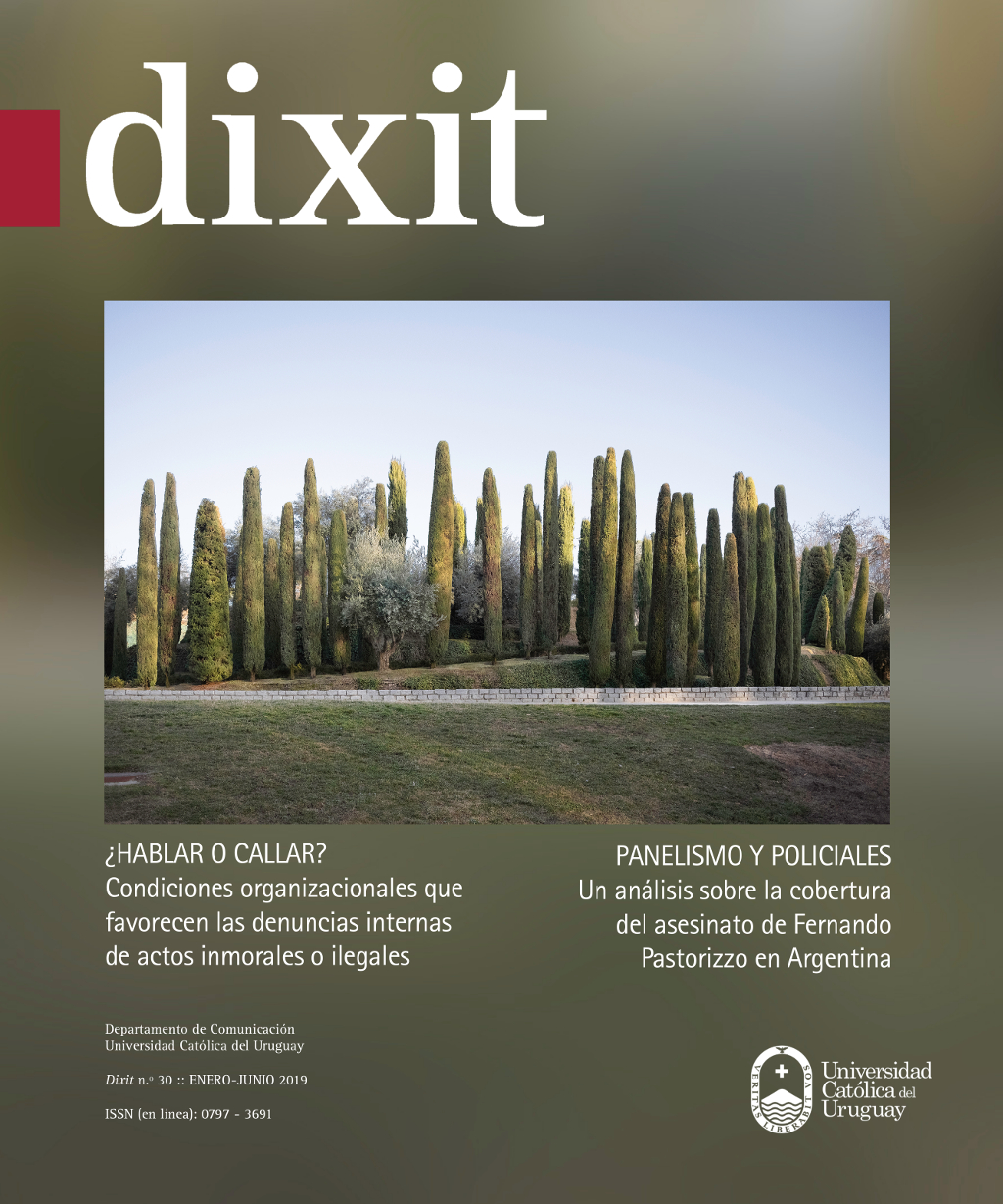El valor semiótico de la fotografía de archivo en la negociación de sentido sobre el pasado reciente. Análisis de una pieza fotográfica de Amnistía Internacional sobre los desaparecidos
DOI:
https://doi.org/10.22235/d.v0i30.1774Palabras clave:
fotografía de archivo, identidad colectiva, memoria cultural, desaparecidos, representaciónResumen
Este trabajo se encuadra dentro de la discusión sobre la fotografía de archivo como recurso semiótico valioso para la negociación de sentido que un colectivo social hace de su pasado reciente. En este marco, se propone un análisis semiótico de una de las piezas fotográficas que integran la campaña de Amnistía Internacional Uruguay sobre los detenidos-desaparecidos (2012). El análisis sugiere que las fotografías pertenecientes a los archivos privados de los detenidos-desaparecidos y sus familiares juegan un rol importante en el proceso de sanación colectiva, en tanto contribuyen a la creación del actor colectivo de los ‘desaparecidos’ en el discurso social. En tanto recursos visuales enmarcados en un determinado contexto de sentido, las fotografías de archivo ameritan un estudio desde la semiótica.
Descargas
Citas
Anderson, B. (1983). Imagined Communities. Londres, Inglaterra: Verso.
Assmann, J. (2008). Communicative and Cultural Memory. En A. Erll, y A. Nünning (Eds.), Cultural Memory Studies (pp. 109-118). Berlín, Alemania/Nueva York, NY: De Gruyter.
Bellentani, F., y Panico, M. (2016). The meaning of monument and memorials: toward a semiotic approach. Punctum. International Journal of Semiotics, 2(1), 28-46.
Berger, P., y Luckmann, T. (1966). The Social Construction of Reality. Londres, Inglaterra: Penguin.
Blejmar, J., Fortuny, N., y García, L. (Eds.). (2013). Instantáneas de la memoria. Fotografía y dictadura en Argentina y América Latina. Buenos Aires, Argentina: Libraria.
Da Silva Catela, L. (2009). Lo invisible revelado. El uso de fotografías como (re)presentación de la desaparición de personas en Argentina. En C. Feld, y J. Stites Mor (Comps.), El pasado que miramos. Memoria e imagen ante la historia reciente (pp. 337-361). Buenos Aires, Argentina: Paidós.
Da Silva Catela, L. (2012). Re-velar el horror. Fotografía, archivos y memoria frente a la desaparición de personas. En I. Piper, y B. Rojas (Eds.), Memorias, historia y derechos humanos (pp. 157-175). Santiago de Chile, Chile: Universidad de Chile.
Da Silva Catela, L. (2015). Staged memories: Conflicts and tensions in Argentine public memory sites. Memory Studies, 8(1), 9-21.
Del Castillo Troncoso, A. (2015). Representaciones fotográficas en torno a la dictadura en la historiografía argentina reciente. Revue ORDA, 219. Recuperado de https://journals.openedition.org/orda/2077
Del Castillo Troncoso, A. (2016). Fotografía y memoria en la dictadura argentina (1976-1983). Secuencia, 95, 215-258.
Del Castillo Troncoso, A. (2017). Fotografía y memoria. Buenos Aires, Argentina: Fondo de Cultura Económica.
Demaria, C. (2006). Semiotica e memoria. Analisi del post-conflitto. Roma, Italia: Carocci.
Demaria, C. (2012). Il trauma, l'archivio, il testimone. Bolonia, Italia: Bononia University Press.
Demaria, C., y Violi, P. (2017). Arte e memoria. Il Parque de la Memoria y de los derechos humanos di Buenos Aires. Storicamente, 13, 1-23.
Eco, U. (1975). Tratado de semiótica general. Barcelona, España: Lumen.
Escudero Chauvel, L. (2002). Un sujeto patémico: los desaparecidos en la prensa argentina. DeSignis, 2, 187-202.
Escudero Chauvel, L. (2011). Desaparecidos, pasiones e identidades discursivas en la prensa argentina (1976-1983). Letra. Imagen. Sonido. Ciudad mediatizada, 6/7, 41-56.
Feld, C. (2010). Imagen, memoria y desaparición: una reflexión sobre los diversos soportes audiovisuales de la memoria. Aletheia, 1(1). Recuperado de http://www.aletheia.fahce.unlp.edu.ar/numeros/numero-1/feld-claudia.-imagen-memoria-y-desaparicion.-una-reflexion-sobre-los-diversos-soportes-audiovisuales-de-la-memoria
Feld, C. (2014). ¿Hacer visible la desaparición? Las fotografías de detenidos-desaparecidos de la ESMA en el testimonio de Víctor Basterra. Clepsidra. Revista Interdisciplinaria de Estudios sobre Memoria, 1, 28-51.
Feld, C., y Stites Mor, J. (Eds.). (2009). El pasado que miramos. Memoria e imagen ante la historia reciente. Buenos Aires, Argentina: Paidós.
Floch, J. M. (1986). Les formes de l’empreinte. París, Francia: Pierre Fanlac.
Floch, J. M. (1990). Sémiotique, marketing et communication. París, Francia: Presses Universitaires de France.
Floch, J. M. (1995). Identités visuelles. París, Francia: Presses Universitaires de France.
Fontanille, J. (2008). Pratiques sémiotiques. París, Francia: Presses Universitaires de France.
Fortuny, N. (2014). Memorias fotográficas. Imagen y dictadura en la fotografía argentina contemporánea. Buenos Aires, Argentina: La Luminosa.
Gamarnik, C. (2017). La imagen de la “subversión”: cómo se construyó la imagen del enemigo (1976-1979). Sudamérica, 7, 19-52.
García Canclini, N. (1999). La globalización imaginada. Buenos Aires, Argentina: Paidós.
Geertz, C. (1973). The Interpretation of Cultures. New York, NY: Basic Books.
Greimas, A. (1984). Sémiotique figurative et sémiotique plastique. Actes sémiotiques, 6(60). Recuperado de https://www.unilim.fr/actes-semiotiques/5507&file=1/
Hjelmslev, L. (1943). Prolegomena to a Theory of Language. Madison, WI: Wisconsin University Press.
LaCapra, D. (1999). Trauma, Absence, Loss. Critical Inquiry, 25(4), 696-727.
Lorusso, A. M. (2010). Semiotica della cultura. Bari-Roma, Itlalia: Laterza.
Marrone, G. (2011). Introduzione alla semiotica del testo. Bari-Roma, Italia: Laterza.
Marrone, G. (2018). Prima lezione di semiotica. Bari-Roma, Italia: Laterza.
Mazzucchelli, F. (2010) Urbicidio. Il senso dei luoghi tra distruzioni e ricostruzioni in ex Jugoslavia. Bolonia, Italia: Bononia University Press.
Mazzucchelli, F., Van der Larse, R., y Rejnen, C. (Eds). (2014). Introduction. VS, 119, 3-15.
Nora, P. (Dir.). (1997). Les lieux de mémoire. París, Francia: Gallimard.
Pozzato, M. P. (2013). Capire la semiotica. Roma, Italia: Carocci.
Searle, J. (1995). The Construction of Social Reality. Londres, Inglaterra: Penguin.
Sozzi, P. (2017). Tracciare la memoria: come funzionano le tracce spaziali. E |C, 1-7. Recuperado de https://www.academia.edu/35208578/Tracciare_la_memoria_come_funzionano_le_tracce_spaziali
Tamm, M. (2015). Semiotic Theory of Cultural Memory: In the Company of Juri Lotman. En S. Kattago (Ed.), The Ashgate Research Companion to Memory Studies (pp. 127-141). Nueva York, NY: Routledge.
Verón, E. (1989). Semiótica y teoría de la democracia. Revista de Occidente, 92, 130-142.
Violi, P. (2014a). Paesaggi della memoria. Il trauma, lo spazio, la storia. Milán, Italia: Bompiani.
Violi, P. (2014b). Immagini per ricordare, immagini per agire. Il caso della Guerra Sucia argentina. Lexia, 17-18, 619-649.
Descargas
Publicado
Cómo citar
Número
Sección
Licencia
Desde el n.º 32 en adelante todos los contenidos se encuentran bajo la Licencia Creative Commons Atribución 4.0 Internacional (CC BY 4.0).
Las ediciones número 29-31 se encuentran bajo la Licencia Creative Commons Atribución-NoComercial 4.0 Internacional.
Los contenidos correspondientes a los números 28 y anteriores se encuentran bajo la Licencia Creative Commons Atribución-NoComercial-CompartirIgual 4.0 Internacional.


















